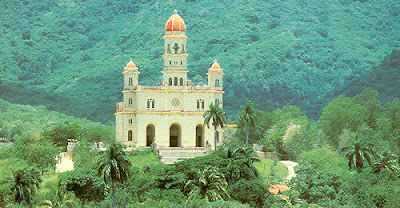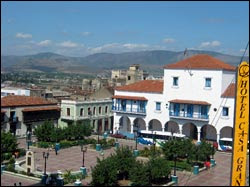 |
| Santiago de Cuba "Jose Bofill's Native Land" Tierra Natal |
From Wikipedia, the free encyclopedia
Santiago de Cuba is the capital city of Santiago de Cuba Province in the south-eastern area of the island nation of Cuba, some 540 miles (870 km) south-east of the Cuban capital of Havana. The municipality extends over 1,023.8 square kilometers (395.3 sq mi), and contains the communities of El Caney, Guilera, Antonio Maceo, Bravo, Castillo Duany, Leyte Vidal and Moncada. Historically Santiago de Cuba has long been the second most important city on the island after Havana, and still remains the second largest. It is on a bay connected to the Caribbean Sea and is an important sea port. In 2004 the city of Santiago de Cuba had a population of about 494,337 people.
History
Santiago de Cuba was founded by Spanish conquistador Diego Velázquez de Cuéllar on June 28, 1514. In 1516 the settlement was destroyed by fire, and was immediately rebuilt. This was the starting point of the expeditions led by Juan de Grijalba and Hernán Cortés to the coasts of Mexico in 1518, and in 1538 by Hernando de Soto's expedition to Florida. The first cathedral was built in the city in 1528. From 1522 until 1589 Santiago was the capital of the Spanish colony of Cuba.
The city was plundered by French forces in 1553, and by British forces under Christopher Myngs in 1662.
The city experienced an influx of French immigrants in the late 18th century and early 19th century, many coming from Haiti after the Haitian slave revolt of 1791. This added to the city's eclectic cultural mix, already rich with Spanish and African culture.
It was also the location where Spanish troops faced their main defeat at San Juan Hill on July 1, 1898, during the Spanish-American War. Spain later surrendered to the United States after the destruction of its Atlantic fleet just outside Santiago's harbor. Cuban poet, writer, and national hero, José Martí, is buried in Cementerio Santa Efigenia.
 |
| Caridad Del Cobre |
Role in the Revolution
Santiago was also the home of the revolutionary hero, Frank País. On July 26, 1953, the Cuban Revolution began with an ill-prepared armed attack on the Moncada Barracks by a small contingent of rebels led by Fidel Castro. Shortly after this disastrous incident, País began talking with students and young working people informally, drawing around him what became an extremely effective urban revolutionary alliance. This developed into highly organized cells coordinating a large scale urban resistance that became instrumental in the success of the Cuban Revolution.
 |
| Santiago de Cuba - Castillo del Morro (Morro Castle) |
País' group prepared carefully, accruing weapons, collecting money, collecting medical supplies. They published a cheap newsletter that reported news that criticized the government, attempting to counter Batista's censorship.
In the summer of 1955, País’ organization merged with Castro's July 26 Movement. País became the leader of the new organization in Oriente province.
On January 1, 1959, Fidel Castro proclaimed the victory of the Cuban Revolution from a balcony on Santiago de Cuba's city hall.
Culture
Santiago de Cuba was the hometown of poet José María Heredia. It houses a museum that displays the extensive art collection of the Bacardí family. Santiago de Cuba is well known for its cultural life. Some of Cuba's most famous musicians, including Compay Segundo, Ibrahim Ferrer and Eliades Ochoa (all of which participated in the Buena Vista Social Club) and trova composer Ñico Saquito (Benito Antonio Fernández Ortiz) were born in the city or in one of the villages surrounding it. They have contributed to the typical, country-like music of the city.
 |
| Parque Cespedes (Park) |
Furthermore, Santiago de Cuba is well-known for its traditional dances, most notably son, from which salsa has been derived, and guaguancó, which is accompanied by percussion music only. The city is also well-known for its Carnival, which is strangely enough celebrated in July. During Carnival, traditional conga music is played in the streets on a typical, pentatonic trumpet, called the trompeta china.
A relatively high number of residents of the city adhere to Afro-Cuban religions, most notably santería. The city hosts an important community of descendants from Haitian immigrants from the 19th century. Some aspects of the religious "vodún" heritage of the city can be traced back to this community.









